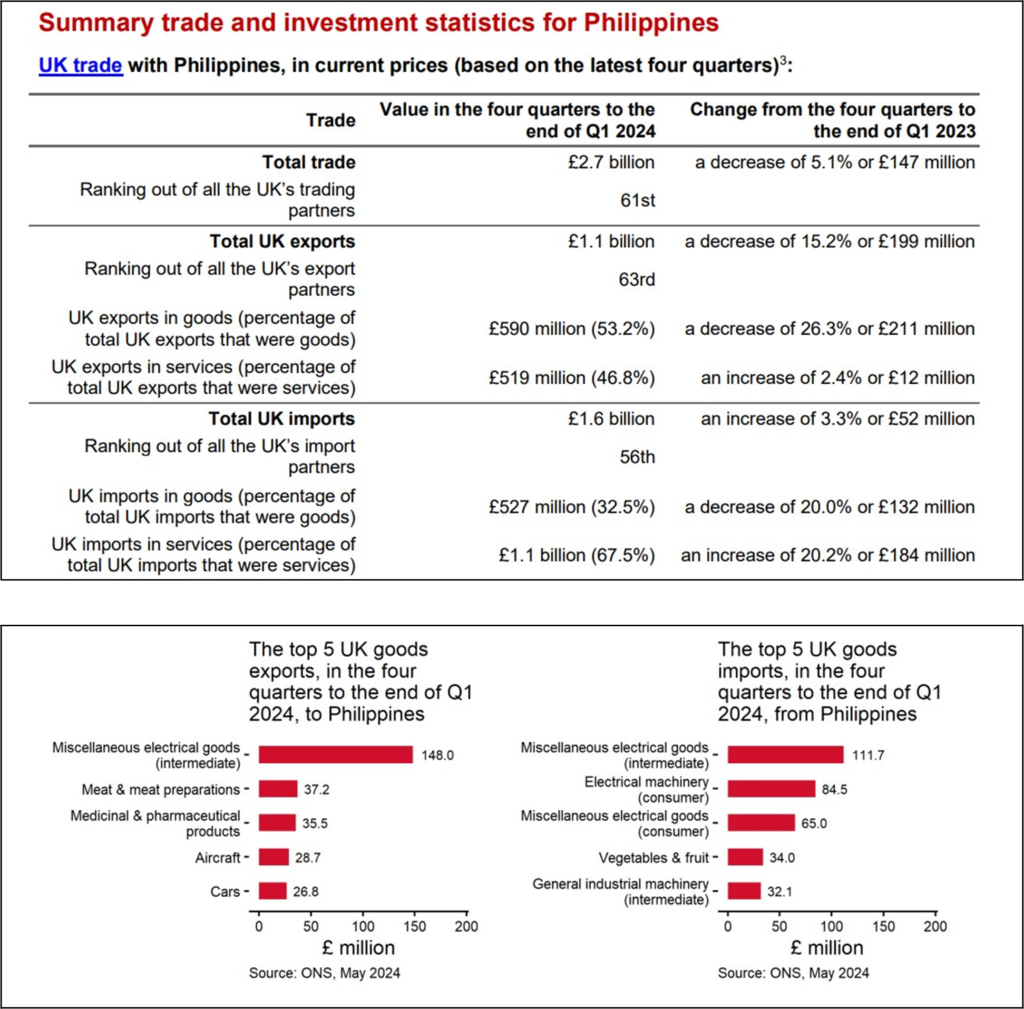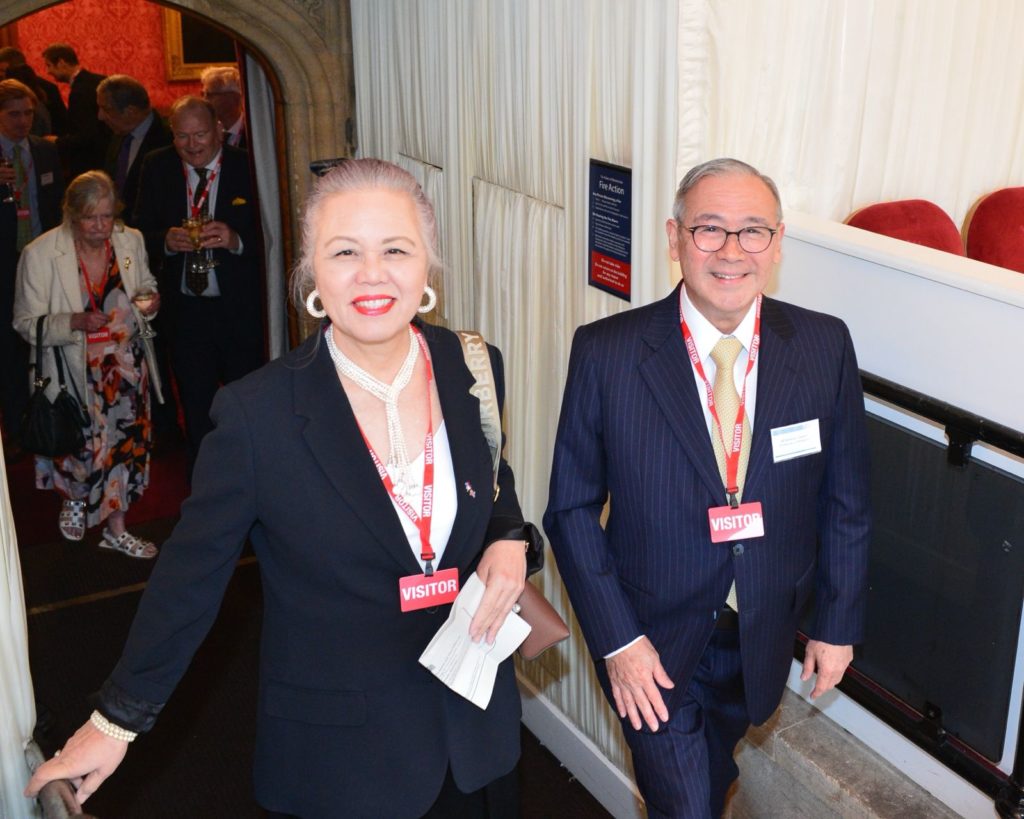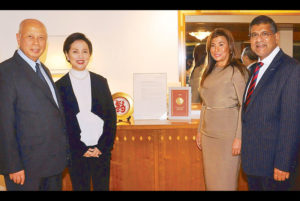PHILIPIINES ECONOMIC PERFORMANCE AND INDICATORS
 as presented at
as presented at
the recent Breakfast meeting
of the PBBC
in London
Gross Domestic Product
• The Philippine’s Gross Domestic Product (GDP) grew by 6.9 percent in the third quarter of 2017. GDP grew by 6.5 percent in the second quarter of 2017 and 6.4 percent in the first half of the year.
• Manufacturing, Trade, and Real Estate, Renting and Business Activities were the main drivers of growth for the quarter.
• Among the major economic sectors, Industry recorded the fastest growth of 7.5 percent followed by Services with 7.1 percent growth. Meanwhile, Agriculture slowed down by 2.5 percent from 3.0 percent growth in the previous year.
• Net Primary Income from the Rest of the World (NPI) grew by 5.7 percent compared with the 4.1 percent growth recorded in the same quarter of the previous year. As a result, Gross National Income (GNI) posted a growth of 6.7 percent.
• With the country’s projected population reaching 104.9 million in the third quarter of 2017, per capita GDP grew by 5.4 percent. Meanwhile per capita GNI and per capita Household Final Consumption Expenditure grew by 5.2 percent and 3.0 percent, respectively.
Trade / Exports / Imports
• From January to June 2017 (First Semester), Philippines’ total external trade in goods was recorded at $75.586 billion, expanding by 15.3 percent from $65.579 billion in 2016.
• Total imports payments went up by 14.3 percent to $44.302 billion in 2017 from $38.746 billion in 2016, whereas, total export receipts grew by 16.6 percent to $31.284 billion in 2017 from $26.832 billion in 2016.
• This brought the country’s balance of trade in goods (BoT-G) at $13.017 billion deficit in January to June 2017, higher than the $11.914 billion deficit in same period of 2016.
Inflation
• The year-on-year headline inflation at the national level further accelerated by 3.5 percent in October 2017. In the previous month, inflation was posted at 3.4 percent and in October 2016, 2.3 percent.
• The indices of the following commodity groups recorded higher annual increases during the month: Alcoholic Beverages and Tobacco (6.8%); Housing, Water, Electricity Gas and Other Fuels (4.0%); Communication (0.4%); Recreation and Culture (1.5%); and Restaurant and Miscellaneous Goods and Services (2.6%).
Employment
• As of July 2017, the unemployment rate inched up to 5.6 percent from 5.4 percent a year ago as more Filipinos joined the labour force.
• Estimates showed that 94.4 percent of the labour force population were employed in July, slightly down from 94.6 percent last year.
Budget (Revenues and Expenditure)
• From January to October, revenues rose by a tenth to P2.007 trillion from last year’s P1.821 trillion.
• Tax and non-tax revenues, meanwhile, grew 17 percent to P205.1 billion in October from a year ago’s P174.6 billion.
• The collections of the bureaus of Internal Revenue and of Customs, the country’s two biggest tax-collection agencies, increased 17 percent year-on-year to P142.5 billion and 29 percent to P42.9 billion, respectively.
• The national government widened its budget deficit that month by 830 percent to P21.8 billion from P2.3 billion a year ago. The national government continued to underspend during the first 10 months of the year, as expenditures of P2.241 trillion were 7-percent lower than the programmed disbursements of P2.403 trillion.
Foreign Direct Investment / Portfolio Investment
• Foreign direct investments (FDI) grew by 182.7 percent to US$674 million in June 2017 from US$238 million for the same month in 2016, reflecting investors’ continued bullish outlook on the Philippine economy.
• On a cumulative basis, FDI registered net inflows of US$3.6 billion in the first half of 2017. This was 14 percent lower than the US$4.2 billion net inflows posted in the same period last year on account of the 90.3 percent decline in net equity capital to US$141 million from US$1.4 billion a year ago.
• Equity capital infusions during the first semester were sourced mainly from the United States, Japan, Singapore, Hong Kong, and Taiwan. These were invested mainly in real estate; financial and insurance; manufacturing; electricity, gas, steam and air conditioning supply; and wholesale and retail trade activities.
Foreign Exchange Reserves
• The country’s foreign exchange buffer improved to a three-month high of $81.51 billion in August, $447.9 million higher than the revised $81.06 billion recorded in July.
• The latest gross international reserves level was the highest since hitting $82.18 billion in May.
• The build-up in reserves was due mainly to inflows arising from the revaluation adjustments on the Central Bank’s gold holdings resulting from the increase in the price of gold in the international market.
• Data showed the BSP’s gold holdings went up 5.3 percent to $8.43 billion in August from $8 billion in July.
Remittances
• During the first seven months of the year, personal remittances from Overseas Filipinos increased by 5.9 percent at $17.9 billion, compared to the same period last year.
• The sustained increase in OF remittances was supported by stable demand for skilled Filipino workers abroad.
• Preliminary data from the Philippine Overseas Employment Administration showed that in January to July 2017, the total number of deployed OF workers reached 1,222,003 which is about 58 percent of the total number of OF workers deployed for the year 2016 at 2,112,331.
• Cash remittances coming from the US, Saudi Arabia, UAE, Singapore, Japan, United Kingdom, Qatar, Kuwait, Germany and Hong Kong comprised accounted for 80 percent of total cash remittances in the first seven months of the year.
Tourists
• Consistent growth is observed by the Philippines’ inbound traffic with a total of 2,8 million visitors for the first five months of 2017. This volume registered double-digit increase of 14.43% from the 2,5 million count for the same period last year.
• The biggest volume was recorded in the month of January while the highest growth was registered in April. Another milestone was achieved by the industry as month to month arrivals has surpassed the 500,000 visitor volume for the first five months of the year.
• Arrivals from the UK have reached 82,000 within the said period. The UK still ranks as the 8th top visitor market for the Philippines.











Recent Comments